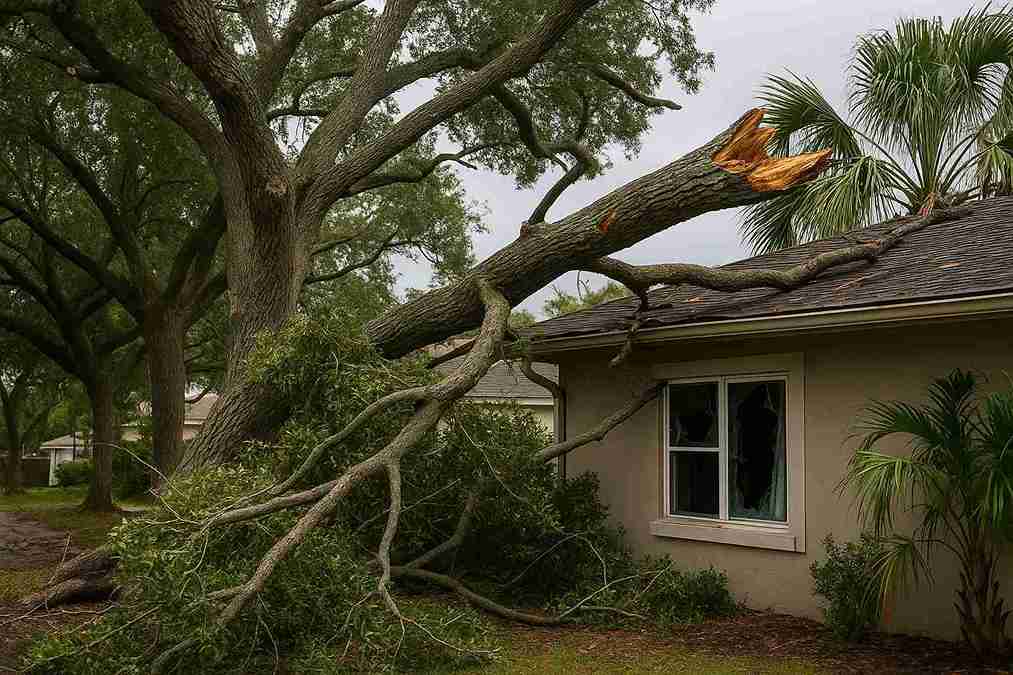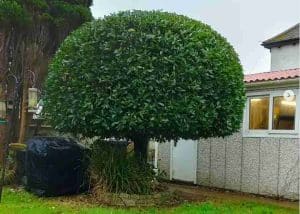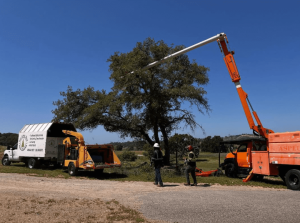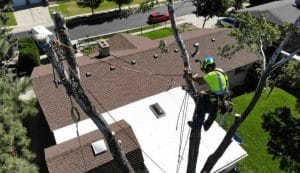Unpruned trees in Florida can cause major storm damage broken limbs, fallen trunks, and blocked roads that lead to thousands of dollars in repairs. When tree branches grow too long or weak, they’re far more likely to snap during hurricanes and tropical storms, damaging your roof, siding, vehicles, and even power lines. That’s why regular tree pruning isn’t just optional in Florida, it’s a critical part of protecting your property.
This article breaks down exactly how skipping tree pruning puts your home at risk, why Florida’s climate makes it even more important, and the practical steps you can take to prevent costly storm damage. With a focus on safety, savings, and long-term peace of mind, we’ll show you how proactive pruning keeps your trees healthy and your home secure season after season.
Table of Contents

The Hidden Risks of Unpruned Trees in Florida’s Storm Season
Florida’s storm season, running from June to November, brings heavy winds, torrential rain, and sometimes hurricanes. While you might prepare your home by boarding windows or stocking supplies, your trees often get overlooked. Unpruned trees can become ticking time bombs, posing risks to your home, family, and wallet.
When trees aren’t regularly trimmed, weak or overgrown branches can snap under strong winds. These falling limbs can crash into your roof, shatter windows, or damage vehicles. According to the National Weather Service, wind speeds in a Category 1 hurricane (74-95 mph) are enough to break branches and topple poorly maintained trees. In Florida, where storms are frequent, this isn’t a rare event—it’s a real threat.
Beyond property damage, unpruned trees can block driveways or roads, making it hard for emergency services to reach you. Power lines are also at risk; a single fallen branch can knock out electricity for your entire neighborhood. The result? You’re left with costly repairs, higher insurance claims, and stress that could have been avoided with simple tree care.
How Tree Pruning Prevents Costly Storm Damage
Pruning isn’t just about making trees look neat; it’s a practical way to strengthen them against Florida’s wild weather. Here’s how proper tree pruning saves you money and headaches:
1. Removes Weak and Dead Branches
Dead or weak branches are the first to break in a storm. Pruning cuts these liabilities away, leaving only strong, healthy limbs that can withstand high winds. This simple step can prevent branches from crashing into your home or car.
2. Improves Tree Structure
Overgrown trees with unbalanced canopies are more likely to topple. Pruning shapes the tree, reducing wind resistance and helping it stand firm during gusts. A well-structured tree is less likely to uproot, saving you from costly tree removal or foundation repairs.
3. Reduces Debris Risks
Storms scatter loose branches and leaves, clogging drains or piling up on your property. Pruning minimizes this debris, lowering the chance of flooding or cleanup costs. Fewer fallen branches also mean less risk to your roof or siding.
4. Protects Power Lines and Utilities
Trees growing too close to power lines are a major hazard. A single branch can cause outages that take days to fix. Pruning keeps branches clear of utilities, ensuring you stay powered up during a storm.
User benefit: By pruning regularly, you’re not just maintaining trees—you’re preventing thousands of dollars in potential damage. For example, repairing a damaged roof can cost $5,000-$15,000, while pruning a tree typically costs $200-$500. The math is clear: prevention is cheaper than repair.

Why Florida’s Climate Makes Pruning a Must
Florida’s unique climate—hot, humid, and rainy—creates ideal conditions for rapid tree growth. While this keeps your yard green, it also means trees can quickly become overgrown if left unchecked. Here’s why Florida homeowners can’t afford to skip pruning:
- Fast-Growing Trees: Species like pines, oaks, and palms common in Florida grow quickly, producing dense canopies that catch wind like sails. Without pruning, these trees become top-heavy and prone to falling.
- Frequent Storms: Florida faces an average of 7-10 named storms per year, per NOAA data. Unpruned trees are more likely to fail under this constant threat, especially during peak hurricane season.
- Soil Conditions: Florida’s sandy soils offer less root stability than denser soils elsewhere. Pruning reduces canopy weight, helping trees stay anchored during storms.
- Pest and Disease Risks: Humidity encourages pests and fungi, which weaken trees. Pruning removes infected branches, keeping trees healthy and storm-resistant.
What this means for you: Florida’s climate demands proactive tree care. Regular pruning keeps your trees strong, reducing the chance of storm-related disasters. It’s an investment in your property’s safety and value.
Common Mistakes Homeowners Make by Skipping Pruning
Many Florida homeowners skip tree pruning, thinking it’s unnecessary or too expensive. But this choice often leads to bigger problems. Here are the most common mistakes and why they’re risky:
1. Assuming Trees Are Fine Without Maintenance
Trees might look healthy but hide weak spots like dead branches or poor structure. Storms expose these flaws, turning “healthy” trees into hazards. Regular pruning spots and fixes issues before they escalate.
2. Waiting Until Storm Season to Act
Pruning right before a storm is often too late. Last-minute cuts can stress trees, making them more vulnerable. Plan pruning in late winter or early spring to prepare trees for hurricane season.
3. Thinking Pruning Is Just Cosmetic
Some homeowners see pruning as a luxury, not a necessity. In reality, it’s about safety and prevention. A well-pruned tree is less likely to cause damage, saving you from costly repairs.
4. Ignoring Small Trees
Even young or small trees need pruning to develop strong structures. Neglecting them can lead to weak growth, making them future storm risks.
Takeaway for you: Avoiding these mistakes saves time, money, and stress. Pruning isn’t optional in Florida—it’s a critical step to protect your home from storm damage.
How to Know When Your Trees Need Pruning
Not sure if your trees need attention? Look for these signs that pruning is overdue:
- Dead or Broken Branches: Visible deadwood or cracked limbs are a clear red flag.
- Overgrown Canopy: If branches block sunlight or touch your home, they’re too long.
- Leaning Trees: A tree leaning toward your house or power lines is a hazard.
- Crowded Branches: Branches rubbing together can weaken and break in storms.
- Sprouts at the Base: Excessive growth at the tree’s base steals nutrients, weakening it.
If you notice these signs, don’t wait for a storm to test your trees. Pruning now can prevent damage later. For larger trees or those near power lines, hire a professional to ensure safe, proper cuts.
Why it helps you: Spotting these signs early lets you act before small issues become big expenses. It’s about staying ahead of problems, not reacting to them.
Practical Steps to Start Pruning and Protect Your Property
Ready to make your trees storm-ready? Follow these steps to get started:
1. Inspect Your Trees Regularly
Walk your property every few months, looking for signs of overgrowth or damage. Early detection makes pruning easier and cheaper.
2. Schedule Pruning Annually
Plan pruning for late winter or early spring, before storm season ramps up. Annual maintenance keeps trees healthy and hazard-free.
3. Hire a Certified Professional
For large trees or complex jobs, choose a certified arborist. They know how to prune safely and effectively, ensuring your trees are storm-resistant. Search for “certified arborist near me” to find local experts.
4. Focus on High-Risk Trees
Prioritize trees near your home, power lines, or driveways. These pose the biggest threat during storms, so tackle them first.
5. Maintain After Pruning
Keep trees healthy with proper watering and fertilization. Strong trees are less likely to fail, even in severe weather.
End result for you: By following these steps, you’ll reduce storm risks, save money on repairs, and boost your property’s curb appeal. It’s a win-win for safety and value.
The Long-Term Benefits of Regular Tree Pruning
Investing in tree pruning pays off beyond storm season. Here’s how it benefits you year-round:
- Increased Property Value: Well-maintained trees boost curb appeal, adding up to 15% to your home’s value, per real estate studies.
- Lower Insurance Costs: Insurers often offer discounts for homes with proactive storm prep, including tree care.
- Improved Safety: Pruned trees are less likely to fall, keeping your family and neighbors safe.
- Healthier Trees: Regular pruning promotes growth, reducing disease and pest risks.
- Energy Savings: Strategically pruned trees provide shade, lowering cooling costs in Florida’s hot climate.
Why you’ll love it: Pruning isn’t just about avoiding damage—it’s about enhancing your home’s beauty, safety, and efficiency. It’s a small effort with big rewards.
Addressing Common Concerns About Pruning Costs
Worried about the cost of pruning? Let’s break it down:
- Average Costs: Pruning a single tree in Florida costs $200-$500, depending on size and location. Compare that to $5,000-$20,000 for storm damage repairs.
- DIY vs. Professional: Small trees might be DIY-friendly, but large or risky trees require pros to avoid injury or improper cuts.
- Long-Term Savings: Spending a few hundred dollars now prevents thousands in future costs, from roof repairs to tree removal.
What this means for you: Pruning is an affordable way to protect your home. It’s not an expense it’s an investment in your property’s future.
Conclusion: Don’t Let Unpruned Trees Cost You During Florida’s Storms
Skipping tree pruning might seem like a way to save time or money, but in Florida’s stormy climate, it’s a gamble that can lead to costly damage. Unpruned trees are more likely to break, fall, or cause chaos during hurricanes, leaving you with hefty repair bills and stress. By investing in regular pruning, you protect your home, boost safety, and save money in the long run.
Start today by inspecting your trees, scheduling annual pruning, and finding a trusted local arborist. The peace of mind knowing your property is storm-ready is worth every penny. Don’t wait for the next hurricane warning—take control now and keep your home safe.
FAQs
When should I prune trees in Florida?
The best time to prune trees in Florida is during late winter to early spring. This timing helps trees heal before the active growing season and reduces the risk of disease and pest infestations.
How does pruning prevent storm damage?
Pruning removes weak or dead branches that could break off during storms, reducing the chance of property damage. It also improves tree structure, making them more resilient to high winds.
What are signs my tree needs pruning?
Look for dead or broken branches, overgrown limbs touching structures, leaning trunks, crowded branches, or sprouts at the base. These signs indicate it’s time for pruning to maintain tree health and safety.
How much does tree pruning cost in Florida?
Tree pruning costs in Florida typically range from $200 to $500 per tree, depending on size and location. Investing in regular pruning can prevent costly storm damage repairs.
Can unpruned trees cause power outages?
Yes, overgrown branches can fall onto power lines during storms, leading to outages. Regular pruning keeps branches clear of utilities, ensuring continuous power supply and safety.
Why is Florida’s climate a concern for trees?
Florida’s hot, humid, and rainy climate promotes rapid tree growth, making regular pruning essential to prevent overgrown branches that can become hazardous during storms.
Is pruning necessary for small trees?
Yes, even small or young trees benefit from pruning to develop strong structures. Neglecting them can lead to weak growth, making them susceptible to storm damage in the future.
What happens if I skip tree pruning?
Skipping pruning can result in overgrown, weak branches that are more likely to break during storms, potentially causing property damage and increasing cleanup and repair costs.
How often should trees be pruned in Florida?
Most trees in Florida should be pruned annually or every few years, depending on the species and growth rate. Regular inspections help determine the appropriate pruning schedule
Should I hire a professional for pruning?
For large trees or those near structures and power lines, it’s best to hire a certified arborist. They have the expertise and equipment to prune safely and effectively.



